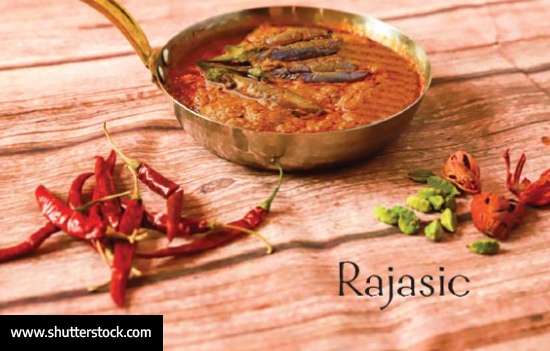- Why a pure diet
improves our emotional balance and makes it easier for us to connect with God
through bhakti and meditation.
According to hindu spirituality, nature has installed diverse mechanisms within each of us that influence our temperament and contribute to our personal differences. At an inner level, the different ratios of the three modes of nature in a person - sattva (goodness), rajas (passion) and tamas (darkness)—strongly influence our temperament and what we eat.
While the predominance of sattva in a person causes
health-conscious consumption of food, which is said to improve longevity,
intellect and happiness (Bhagavad Gita 17:8), rajas in predominance causes
taste-conscious consumption that may even lead to disease. In contrast, tamas
causes consumption of food out of ignorance, with little regard to health or
taste.


This article was first published in Hinduism Today.
Sattvic foods include fresh vegetarian
eatables, both raw and cooked, like fruits, most vegetables, cereals, rice,
milk, fresh breads and lentils. Rajasic foods include unnecessarily spicy
foods, excessively salty foods and soft drinks. Tamasic foods are spoiled,
tasteless, unclean, and/or harmful food items. This category includes most
deep-fried or processed foods, hard liquor, meat, fish and eggs. It can be
noted that all sattvic foods are vegetarian, but many vegetarian eatables may
be categorized as rajasic or tamasic.
Irrespective of the yogic path we choose
to progress towards God - bhakti yoga (the path of devotion), karma yoga (the
path of selfless action), jnana yoga (the path of knowledge), or raja yoga (the
path of meditation) - a sattvic diet makes our spiritual progress easier.
Hindus do not believe that a vegetarian person is necessarily a better person
than a non-vegetarian person. They believe that eating sattvic foods makes
progress relatively easier on a yogic path.
Food and Our
Thinking
There is a two-way connection between
food and disposition: While sattvic people prefer to eat sattvic food, eating
sattvic food can make a person more sattvic. We can also say that performing
sattvic karma in one area of life increases sattva in all other areas of life.
In the context of disposition, because
the sattva mode of nature signifies idealism and involves goodness in all its
forms - like truth, honesty, discipline, perseverance, politeness and
enthusiasm in work - eating sattvic food leads to the development of such
virtues. A sattvic diet propels our disposition towards righteousness - including
how we think and act. Moreover, by increasing the elements of sattva within us,
sattvic foods can inspire us to participate in bhakti and meditation and move
towards God.
In the workplace, while performing
professional tasks, sattvic foods influence us to remain emotionally balanced
in success and failure. In contrast, eating rajasic foods may push us towards
greed, self-centeredness and performing work solely for monetary profit.
Tamasic foods can induce the worst qualities in a person, like laziness,
sleepiness, arrogance and deceitfulness, which are all tamasic traits. As
non-vegetarianism falls under the tamasic category, eating non-vegetarian food
amplifies negative samskaras or karmic impressions in the mind of a spiritual
aspirant.
Because karma includes all the thought processes used to arrive at a decision to do or not do something, the intentions involved in preparing our menu can be important in labeling food as sattvic vs. tamasic. In other words, sattvic food includes why we eat something in addition to what we eat. For example, if we are allergic to a fruit but regularly eat it because of an addiction, the same eatable could be counted as rajasic or tamasic. Similarly, if a food item on the tamasic list has been recommended for someone by a nutrition expert to improve the person’s health, the eatable may no longer count as being tamasic.
In Hinduism, support for a sattvic diet
is not solely a bookish concept; it is based on the experiences of spiritually
evolved beings. Sages and saints have experienced the benefits of sattvic foods
over the ages, and some of their experiences have become available to us
through scriptures.
Bhakti
Many Hindus believe that God accepts
whatever is offered to Him (or Her) with love and accordingly they place food
items in front of an image of God in temples and homes to express their bhakti.
While offering food to God, devotees select the purest and healthiest food
items and therefore almost always offer sattvic food items, like sweets,
fruits, milk, purified water, tulsi leaves and rice.
Offering sattvic food to God involves God’s remembrance and worship and develops the habits of serving God and surrendering to Him. As God accepts the love that we offer with food, the food becomes prasadam and is later
consumed by the devotees. In some temples, it is distributed to the needy as a
way of serving fellow beings.
Selecting the right eatables and
offering them to God is a means of spiritual connectivity in many devotional
traditions. The practice of offering sattvic food to God is well supported by
traditional stories from the epics and Puranas, wherein famous devotees offered
sattvic food items such as fruits and rice to Lord Rama, Lord Krishna, and Lord
Siva.
Meditation
During meditation, we can focus better
when fewer distractions are present in our mind. By supporting discipline in
thought, lesser distractions and a calm and balanced mind, a sattvic diet
enhances the quality of our meditation. While sattvic foods help us go deep
within ourselves during meditation and render the mind pure and calm, tamasic
foods promote anger, darkness and inertia. Our mind becomes purified by
purifying our food; whereas mind-control becomes almost impossible when meat
and liquor are regularly consumed.
Because a sattvic diet involves
transcending taste gratification, regularly following such a diet involves a
good level of austerity, which may be necessary for every spiritual seeker.
In fact, human beings may be the only
living species on earth who have the ability to renounce their instincts for
gratifying taste while progressing in yoga. Just as fewer distractions in the
mind can help a spiritual seeker meditating on a form of God, fewer
distractions can help a seeker chanting the name of Lord Rama or the name of
Lord Siva on the path of bhakti. Also, because of their agreement with the
principles of Ayurveda, sattvic foods support better health for the spiritual
seeker.
Compassion
In a famous story from the Siva Purana, a
huntsman sitting on the branch of a tree unknowingly pushed some leaves and
water on a Shivalinga that was situated near the base of the tree. As a result
of this devotional act, the man developed compassion and could no longer kill
animals for a living.
This anecdote highlights how devotion,
compassion for other beings and spiritual transformation are interrelated,
irrespective of whether we have opted for the path or bhakti or meditation. Not
only does compassion encourage progress in spirituality, true spiritual
progress is expected to induce compassion within us and make us opt for
vegetarian, sattvic foods.
Vegetarianism involves living peacefully
with other life forms and creating minimal ecological disturbances. Because
selection of sattvic foods is directly related to compassion towards other life
forms, spiritual seekers on a yogic path follow a sattvic diet rather than a
tamasic one. Practicing nonviolence (ahimsa) is one of the yamas of yoga and is
integral to spiritual growth. A compassionate person practicing nonviolence can
more effectively express his or her love for God on the path of bhakti and can
better focus on God on the path of meditation.
Reverence for Cows
Beef is strictly forbidden for Hindus,
even for Hindus on a non-vegetarian diet. However, milk and some dairy products
are considered sattvic and are often recommended. Cows are not to be hurt for
our food but revered. Reverence for cows indicates compassion towards all
living beings and support for vegetarianism. According to Mahatma Gandhi,
protecting the cow signifies protection of beings that are helpless and weak in
the world.
Beyond Nature
Whether we opt for the path of bhakti or the path of meditation to connect with God, we must remember that God transcends the three modes of nature (the gunas) and is beyond sattva. Accordingly, maintaining a sattvic lifestyle is not the final aim of human life; the main purpose of human life is to realize God. This is why we participate in yoga—it takes us closer to God. Once we reach God, we automatically transcend the three gunas of nature.
Author is an American spiritual writer and blogger currently
living in India. He is formally trained in Indian classical music and has a PhD
in chemical and biomolecular engineering at the University of Pennsylvania.
Please see mukulshrigoel.com
This article was first published in Hinduism Today
and Here
eSamskriti has obtained permission from Hinduism Today to share.